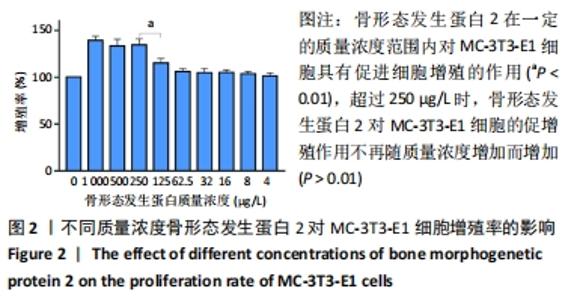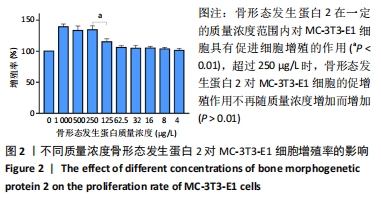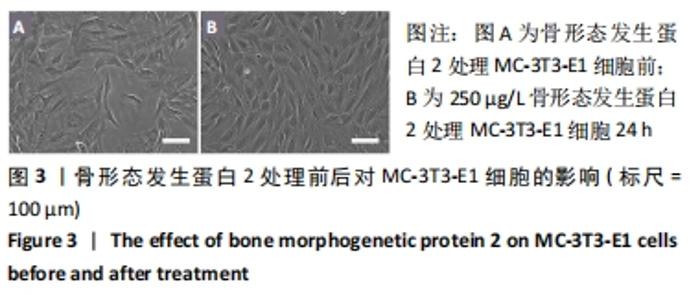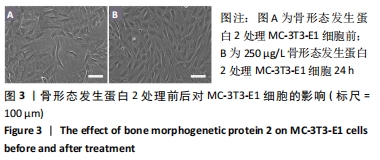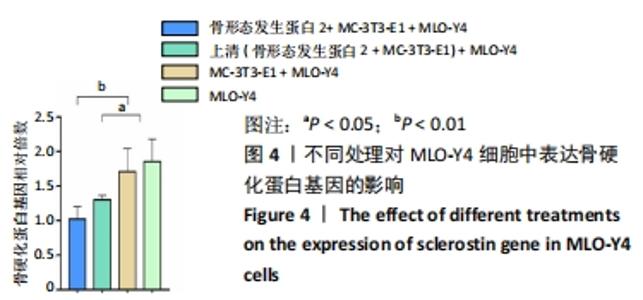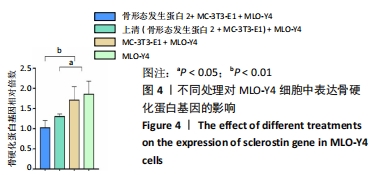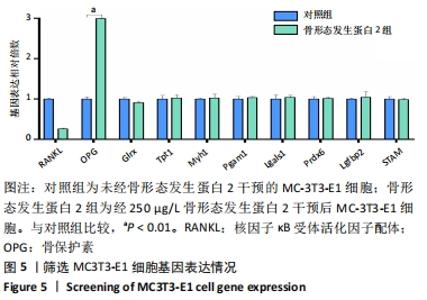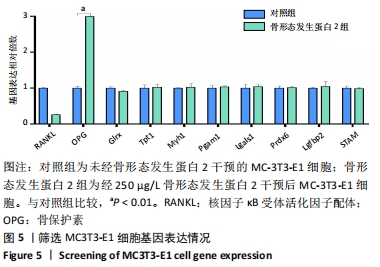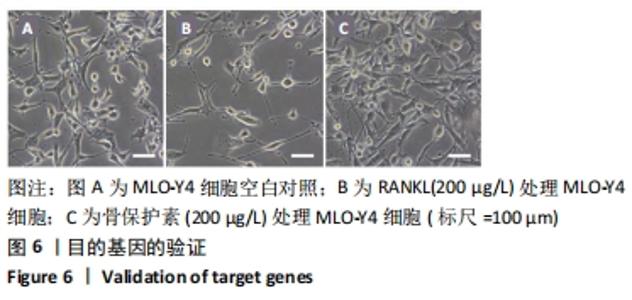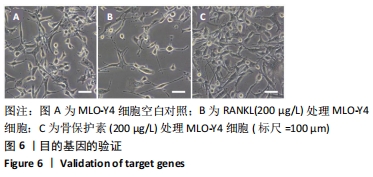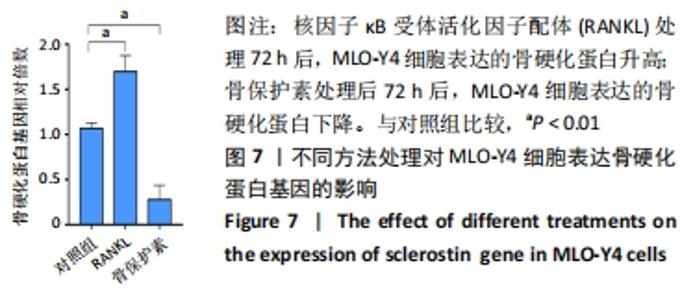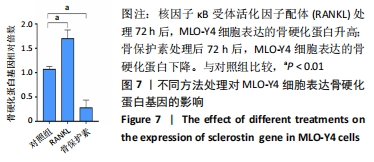Chinese Journal of Tissue Engineering Research ›› 2022, Vol. 26 ›› Issue (11): 1686-1691.doi: 10.12307/2022.352
Previous Articles Next Articles
The mechanism by which bone morphogenetic protein 2 indirectly regulates sclerostin expression in osteocytes
Tian Zhuang1, Wang Diaodiao1, Zhang Chu2, Li Hanchen2, Zhou Jian2, Yao Qi1, 2
- 1Department of Orthopedics, Peking University Ninth Clinical School, Beijing Shijitan Hospital, Capital Medical University, Beijing 100038, China; 2Department of Orthopedics, Beijing Shijitan Hospital, Capital Medical University, Beijing 100038, China
-
Received:2021-02-18Revised:2021-02-22Accepted:2021-03-31Online:2022-04-18Published:2021-12-11 -
Contact:Yao Qi, MD, Professor, Department of Orthopedics, Peking University Ninth Clinical School, Beijing Shijitan Hospital, Capital Medical University, Beijing 100038, China; Department of Orthopedics, Beijing Shijitan Hospital, Capital Medical University, Beijing 100038, China -
About author:Tian Zhuang, Master candidate, Department of Orthopedics, Peking University Ninth Clinical School, Beijing Shijitan Hospital, Capital Medical University, Beijing 100038, China -
Supported by:Beijing Training Project for Tens of Millions of Talents, No. 2019A33 (to YQ); Capital Health Research and Development Special Project, No. 2020-2-2082 (to YQ)
CLC Number:
Cite this article
Tian Zhuang, Wang Diaodiao, Zhang Chu, Li Hanchen, Zhou Jian, Yao Qi. The mechanism by which bone morphogenetic protein 2 indirectly regulates sclerostin expression in osteocytes[J]. Chinese Journal of Tissue Engineering Research, 2022, 26(11): 1686-1691.
share this article
Add to citation manager EndNote|Reference Manager|ProCite|BibTeX|RefWorks
| [1] JOHNSTON CB, DAGAR M. Osteoporosis in Older Adults. Med Clin North Am. 2020;104(5):873-884. [2] COTTS KG, CIFU AS. Treatment of Osteoporosis. JAMA. 2018;319(10): 1040-1041. [3] ENSRUD KE, CRANDALL CJ. Osteoporosis. Ann Intern Med. 2017;167(3): 17-32. [4] LORENTZON M. Treating osteoporosis to prevent fractures: current concepts and future developments. J Intern Med. 2019;285(4):381-394. [5] LIU Y, YU P, PENG X, et al. Hexapeptide-conjugated calcitonin for targeted therapy of osteoporosis. J Control Release. 2019;304:39-50. [6] TANAKA S, MATSUMOTO T. Sclerostin: from bench to bedside. J Bone Miner Metab. 2020 Nov 18. doi: 10.1007/s00774-020-01176-0. [7] FABRE S, FUNCK-BRENTANO T, COHEN-SOLAL M. Anti-Sclerostin Antibodies in Osteoporosis and Other Bone Diseases. J Clin Med. 2020; 9(11):3439. [8] 章暐, 邹剑, 张长青. 骨硬化蛋白与绝经后妇女脆性骨折的相关性 [J]. 第二军医大学学报,2017,38(9):1206-1210. [9] DEAN DB, WATSON JT, JIN W, et al. Distinct functionalities of bone morphogenetic protein antagonists during fracture healing in mice. J Anat. 2010;216(5):625-630. [10] HASHIMOTO K, KAITO T, FURUYA M, et al. In vivo dynamic analysis of BMP-2-induced ectopic bone formation. Sci Rep. 2020;10(1):4751. [11] ZHANG Y, YANG W, DEVIT A, et al. Efficiency of coculture with angiogenic cells or physiological BMP-2 administration on improving osteogenic differentiation and bone formation of MSCs.J Biomed Mater Res A. 2019;107(3):643-653. [12] SIMPSON AH, MILLS L, NOBLE B. The role of growth factors and related agents in accelerating fracture healing. J Bone Joint Surg Br. 2006;88(6): 701-705. [13] LIU DB, SUI C, WU TT, et al. Association of Bone Morphogenetic Protein (BMP)/Smad Signaling Pathway with Fracture Healing and Osteogenic Ability in Senile Osteoporotic Fracture in Humans and Rats. Med Sci Monit. 2018;24:4363-4371. [14] MAJIDINIA M, SADEGHPOUR A, YOUSEFI B. The roles of signaling pathways in bone repair and regeneration. J Cell Physiol. 2018;233(4): 2937-2948. [15] KAMIYA N, YE L, KOBAYASHI T, et al. BMP signaling negatively regulates bone mass through sclerostin by inhibiting the canonical Wnt pathway. Development. 2008;135(22):3801-3811. [16] KAMIYA N, KOBAYASHI T, MOCHIDA Y, et al. Wnt inhibitors Dkk1 and Sost are downstream targets of BMP signaling through the type IA receptor (BMPRIA) in osteoblasts. J Bone Miner Res. 2010;25(2):200-210. [17] KAMIYA N, ATSAWASUWAN P, JOINER DM, et al. Controversy of physiological vs. pharmacological effects of BMP signaling: Constitutive activation of BMP type IA receptor-dependent signaling in osteoblast lineage enhances bone formation and resorption, not affecting net bone mass. Bone. 2020;138:115513. [18] SEDAGHATI B, JAHROOMISHIRAZI R, STARKE A, et al. Rat Osteosarcoma Cells as a Therapeutic Target Model for Osteoregeneration via Sclerostin Knockdown. Cells Tissues Organs. 2016;201(5):366-379. [19] 赵明月, 高永红. 老年糖尿病患者饮食对骨质疏松症发生的影响 [J]. 中国现代医药杂志,2020,22(2):47-49. [20] 洪维, 郑松柏, 李慧林,等. 骨折风险评估工具FRAX?评分判定上海社区老年人群实际骨质疏松性椎体骨折(OVF)效用的研究[J]. 复旦学报(医学版),2020,47(1):83-88+100. [21] MACÍAS I, ALCORTA-SEVILLANO N, RODRÍGUEZ CI, et al. Osteoporosis and the Potential of Cell-Based Therapeutic Strategies. Int J Mol Sci. 2020;21(5):1653. [22] ZHANG N, ZHANG ZK, YU Y, et al. Pros and Cons of Denosumab Treatment for Osteoporosis and Implication for RANKL. Aptamer Therapy. Front Cell Dev Biol. 2020;8:325. [23] ROCHEFORT GY, PALLU S, BENHAMOU CL. Osteocyte: the unrecognized side of bone tissue. Osteoporos Int. 2010;21(9):1457-1469. [24] BELLIDO T. Osteocyte-driven bone remodeling. Calcif Tissue Int. 2014; 94(1):25-34. [25] CHEN D, ZHAO M, MUNDY GR. Bone morphogenetic proteins. Growth Factors. 2004;22(4):233-241. [26] TU X, DELGADO-CALLE J, CONDON KW, et al. Osteocytes mediate the anabolic actions of canonical Wnt/β-catenin signaling in bone. Proc Natl Acad Sci U S A. 2015;112(5):E478-486. [27] TRESGUERRES FGF, TORRES J, LÓPEZ-QUILES J, et al. The osteocyte: A multifunctional cell within the bone. Ann Anat. 2020;227:151422. [28] TSUKASAKI M, TAKAYANAGI H. Osteoimmunology: evolving concepts in bone-immune interactions in health and disease. Nat Rev Immunol. 2019;19(10):626-642. [29] DIVIETI PAJEVIC P, KRAUSE DS. Osteocyte regulation of bone and blood. Bone. 2019;119:13-18. [30] SALAZAR VS, GAMER LW, ROSEN V. BMP signalling in skeletal development, disease and repair. Nat Rev Endocrinol. 2016;12(4):203-221. [31] DUMIC-CULE I, PERIC M, KUCKO L, et al. Bone morphogenetic proteins in fracture repair. Int Orthop. 2018;42(11):2619-2626. [32] LI P, BAI Y, YIN G, et al. Synergistic and sequential effects of BMP-2, bFGF and VEGF on osteogenic differentiation of rat osteoblasts. J Bone Miner Metab. 2014;32(6):627-635. [33] HE G, SHI Y, LIM J, et al. Differential involvement of Wnt signaling in Bmp regulation of cancellous versus periosteal bone growth. Bone Res. 2017;5:17016. [34] MALIK Z, ALEXIOU M, HALLGRIMSSON B, et al. Bone Morphogenetic Protein 2 Coordinates Early Tooth Mineralization. J Dent Res. 2018; 97(7):835-843. [35] KONG YY, YOSHIDA H, SAROSI I, et al. OPGL is a key regulator of osteoclastogenesis, lymphocyte development and lymph-node organogenesis. Nature. 1999;397(6717):315-323. [36] UDAGAWA N, KOIDE M, NAKAMURA M, et al. Osteoclast differentiation by RANKL and OPG signaling pathways. J Bone Miner Metab. 2021; 39(1):19-26. [37] ANDERSEN TL, ABDELGAWAD ME, KRISTENSEN HB, et al. Understanding coupling between bone resorption and formation: are reversal cells the missing link. Am J Pathol. 2013;183(1):235-246. [38] BOYCE BF, XING L. Functions of RANKL/RANK/OPG in bone modeling and remodeling. Arch Biochem Biophys. 2008;473(2):139-146. [39] BARON R, KNEISSEL M. WNT signaling in bone homeostasis and disease: from human mutations to treatments. Nat Med. 2013;19(2): 179-192. [40] GLASS DA 2ND, BIALEK P, AHN JD, et al. Canonical Wnt signaling in differentiated osteoblasts controls osteoclast differentiation. Dev Cell. 2005;8(5):751-764. [41] KRAMER I, HALLEUX C, KELLER H, et al. Osteocyte Wnt/beta-catenin signaling is required for normal bone homeostasis. Mol Cell Biol. 2010; 30(12):3071-3085. [42] WEITZMANN MN. Bone and the Immune System. Toxicol Pathol. 2017; 45(7):911-924. |
| [1] | Wang Jing, Xiong Shan, Cao Jin, Feng Linwei, Wang Xin. Role and mechanism of interleukin-3 in bone metabolism [J]. Chinese Journal of Tissue Engineering Research, 2022, 26(8): 1260-1265. |
| [2] | Xiao Hao, Liu Jing, Zhou Jun. Research progress of pulsed electromagnetic field in the treatment of postmenopausal osteoporosis [J]. Chinese Journal of Tissue Engineering Research, 2022, 26(8): 1266-1271. |
| [3] | Yang Sidi, Wang Qian, Xu Nuo, Wang Ronghan, Jin Chuanqi, Lu Ying, Dong Ming. Biodentine enhances the proliferation and differentiation of osteoblasts through upregulating bone morphogenetic protein-2 [J]. Chinese Journal of Tissue Engineering Research, 2022, 26(4): 516-520. |
| [4] | Feng Dongfei, He Hongxu, Xie Qi, Zhang Lili, Zhou Hui, Li Wei. Selection of key genes related to biological functions and regulation pathway in periodontal reconstruction [J]. Chinese Journal of Tissue Engineering Research, 2022, 26(2): 253-259. |
| [5] | Wu Saixuan, Zhang Mi, Dong Ming, Lu Ying, Niu Weidong. Regulatory role of Keap1/Nrf2/ARE signaling pathway in bone homeostasis [J]. Chinese Journal of Tissue Engineering Research, 2022, 26(2): 271-275. |
| [6] | Sun Youqiang, Ma Chao, Liang Mengmeng, Xin Pengfei, Zhang Hua, Xiang Xiaobing. The pivotal role of autophagy in bone cells: bone-related cell activity and bone metabolism [J]. Chinese Journal of Tissue Engineering Research, 2022, 26(2): 276-282. |
| [7] | Fan Danyang, Fu Runze, Mi Jiajing, Liu Chunyan. Expression and role of cannabinoid receptors during bone remodeling [J]. Chinese Journal of Tissue Engineering Research, 2022, 26(2): 283-288. |
| [8] | Luo Mingran, Fan Wenhao, Li Xin, Zhou Peng, Wu Zerui, Yuan Feng. Inhibition of the proliferation and osteogenic differentiation of MC3T3-E1 cells by targeting prostaglandin-endoperoxide synthase 2 [J]. Chinese Journal of Tissue Engineering Research, 2022, 26(12): 1888-1893. |
| [9] | Li Shibin, Xia Tian, Zhang Xiaoyun, Wang Weiwei, Zhou Yi, Lai Yu. Active monomer composition of Epimedium influences the homeostasis of bone resorption and bone formation by regulating osteoporosis related signaling pathways [J]. Chinese Journal of Tissue Engineering Research, 2022, 26(11): 1772-1779. |
| [10] | Li Jingyu, Su Yingying, Bai Ding. Morphological characteristics of subchondral bone in a mouse model of early osteoarthritis [J]. Chinese Journal of Tissue Engineering Research, 2022, 26(11): 1692-1698. |
| [11] | Dong Zhiheng, Gao Yan, Liu Zhen, Han Xiaoqian. Construction of icariin/polycaprolactone nanofiber membrane and its osteogenic ability in vitro [J]. Chinese Journal of Tissue Engineering Research, 2022, 26(10): 1510-1514. |
| [12] | Feng Zhiguo, Sun Haibiao, Han Xiaoqiang. Regulation of proliferation, differentiation and apoptosis of bone-related cells by long-stranded non-coding RNA [J]. Chinese Journal of Tissue Engineering Research, 2022, 26(1): 112-118. |
| [13] | Yang Bingxuan, Jiang Tao, Jia Min, Li Peng, Liao Rongzhen, Li Zhao, Shao Min. Icariin promotes differentiation of mouse preosteoblasts via activating autophagy [J]. Chinese Journal of Tissue Engineering Research, 2022, 26(1): 64-69. |
| [14] | Huang Tao, Cheng Zhijian, Jia Zhiqiang, Zhao Xiaoguang, Wang Lei, Zhai Wenjing, Zhou Yongxin. Mechanism by which miR-146a regulates osteogenic differentiation of adipose derived mesenchymal stem cells [J]. Chinese Journal of Tissue Engineering Research, 2022, 26(1): 70-75. |
| [15] | Wang Jing, Lang Xuemei, Wang Weiqun, Zhang Hanxiang, Zhang Yi, Wang Xin. Participation and regulatory mechanism of interleukin-1 during bone metabolism [J]. Chinese Journal of Tissue Engineering Research, 2021, 25(36): 5851-5858. |
| Viewed | ||||||
|
Full text |
|
|||||
|
Abstract |
|
|||||


